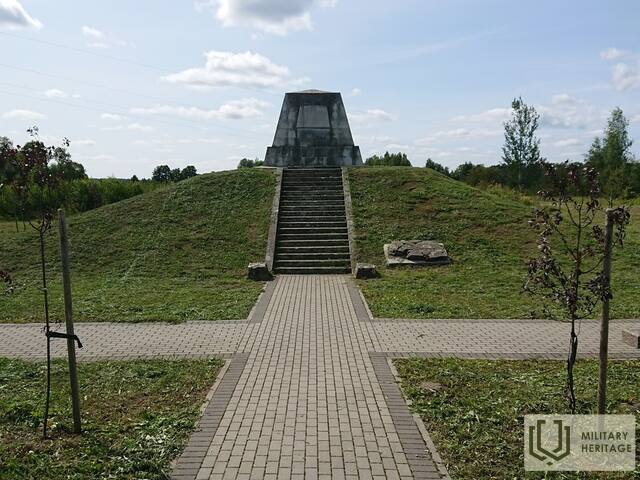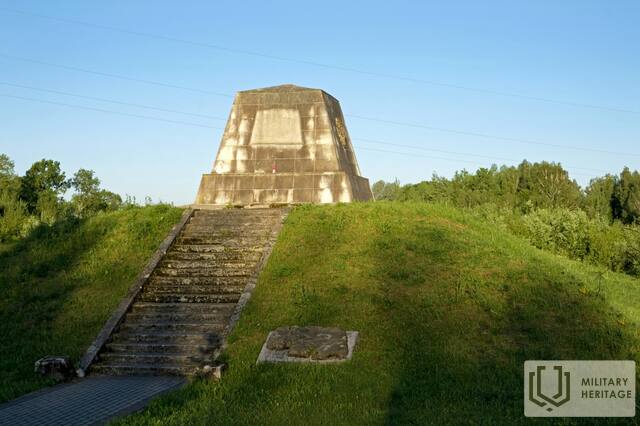Whale Monument Memorial site

The monument is dedicated to the 14 fallen cadets of the Latvian Military School in battles against Bermont's troops in November 1919.
On the side of the Jelgava-Iecava road near the Vareļi house, on May 20, 1935, marking the 15th anniversary of the first graduation of the Latvian Military School, Deputy Prime Minister Marģerts Skujenieks unveiled and army chaplain Pēteris Apkalns consecrated a pyramid-shaped (375x400x400 cm) monument covered with travertine slabs, designed by artist Jānis Borkovskis.
Description of the monument: The monument is built on a 3 m high earthen embankment, where on the eastern side there are entrance stairs with 20 steps and at the foot – 4 massive travertine steps. A sandstone plaque (100x140 cm) was attached to the monument on this side with the text: “Cadets who fell for the independence of Latvia in 1919: Palms Otto, Palms Pauls, Dēliņš Jānis, Pelšs Pēteris, Erdmans Ansis, Skalde Gustavs, Skudruls Verners, Irbe Jūlijs, Rutkis Jānis, Boms Olģerts, Kalniņš Evalds, Lācis Nikolajs, Beļiņka Gustavs, Dzelzkalns Roberts.”
On the opposite – western side, the same plaque engraved: "Military School", on the southern side was the Military School breastplate – a shield with a crossed sword in a raised hand in an oath, and on the northern side – the first breastplate of the Military School cadets.
After the Second World War (in 1951), the monument was blown up. Under the leadership of Laimonis Zalcmanis, it was restored and opened on November 17, 1990. Old details were attached to the northern and western sides, but on the southern side, the meaning of the cadets' chests was recreated by sculptor R.Kalniņa-Grīnberga. The shattered sandstone slab with the names of the fallen was placed at the foot of the embankment near the stairs. The author of the restored monument is Gunārs Heimanis, engineer Edmunds Krūms.
In 2013, the Ozolnieki municipality, with co-financing from the Culture Capital Fund, carried out the restoration of the monument. The restoration work was carried out by restorer Ivo Graudums.
The works were carried out in accordance with the monument restoration methodology developed by Edgars Purviņš – general cleaning of the monument's surface and benches, restoration of damaged seams, repair of the core wall, replacement of damaged cladding panels and protective treatment were carried out. As a result of the aforementioned works, the monument has been protected from adverse climatic conditions and harmful environmental effects in the long term, the visual appearance of the monument and the possibility of reading information have improved.
Used sources and references:
https://nra.lv/foto/izklaide/12388-ozolnieku-novads-cakstes-dzimtas-majas-teteles-tornitis-pieminas-vietas-kritusajiem.htm
https://karavirukapi.blogspot.com/2020/01/salgales-pagasta-pie-vareliem.html
https://www.youtube.com/watch?v=ijWd7OHrjvo














